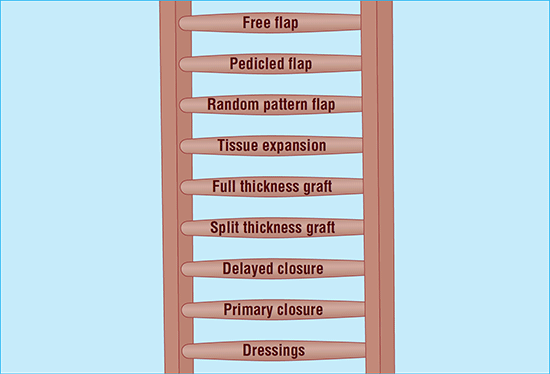There are plenty of reasons to consider ditching sutures and staples.
 SCAR ERASER The use of alternative wound closure technology made the scars from this patient’s knee arthroscopy barely visible two weeks after surgery.
SCAR ERASER The use of alternative wound closure technology made the scars from this patient’s knee arthroscopy barely visible two weeks after surgery.
Most skilled surgeons will tell you there’s nothing superior about using sutures and staples to close wounds. Those same surgeons will likely also tell you that many of the alternative wound-closure devices on the market come pretty darn close to matching their performance, and in fact carry a host of their own advantages, such as:
Patient satisfaction. Many surgical procedures still rely on staples, which require in-person follow-up appointments for removal that are, at best, inconvenient for patients and, at worst, a source of genuine fear. "With a knee revision, we're talking about 30, 40 or 50 staples we need to remove." says Asit K. Shah, MD, PhD, an orthopedic surgeon at Englewood (N.J.) Hospital. Not only can non- or less-invasive adhesive wound closure alternatives remove the need for follow-up staple-removal appointments, but they can also improve patients’ overall impression of your facility. "Patients who see that a surgeon is on the cutting edge and using these staple-free devices will likely tell their friends and family about the facility," says Dr. Shah.
Staff and patient safety. It's fairly common for physicians to get pricked in the process of using sutures, which remain one of the top sharps injury risks. "I was working side by side with a resident," says Richard Vagley, MD, FACS, of Spectrum Aesthetics in Coral Gables, Fla. "I zigged, he zagged, and I wound up with a needle in my finger." Patients are also vulnerable with traditional closing methods, particularly those that employ staples. "With staples, you’re leaving little holes in the body," says Dr. Shah. "That's a possible source of infection. It hasn’t been clinically proven, but it’s always a concern for surgeons."
Ease of use. Many alternative wound closure technologies are simple and intuitive enough to use that surgeons can delegate the process to a surgical assistant, which can greatly benefit your facility’s bottom line. "If you’re operating in two rooms at a busy facility, and you can delegate the closure to an assistant," says Dr. Vagley, "there's potential to complete more cases per day."
Much like NPO and other long-held practices, sutures and staples continue to be used because that's what many surgeons have always done. Administrators now can suggest that their surgeons make the switch to alternative closure methods that are backed by evidence and have proven successful in the field.
.svg?sfvrsn=be606e78_3)



.svg?sfvrsn=56b2f850_5)